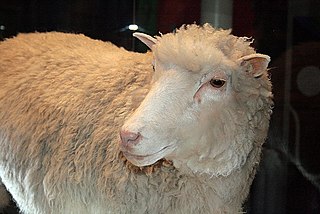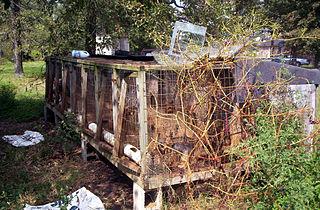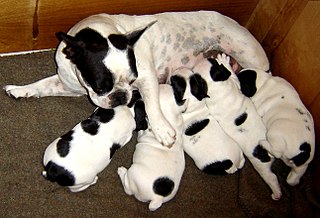
Cloning is the process of producing individuals with identical or virtually identical DNA, either naturally or artificially. In nature, many organisms produce clones through asexual reproduction. Cloning in biotechnology refers to the process of creating clones of organisms or copies of cells or DNA fragments.

Dolly was a female domestic sheep, and the first mammal cloned from an adult somatic cell, using the process of nuclear transfer.

In genetics and developmental biology, somatic cell nuclear transfer (SCNT) is a laboratory strategy for creating a viable embryo from a body cell and an egg cell. The technique consists of taking an enucleated oocyte and implanting a donor nucleus from a somatic (body) cell. It is used in both therapeutic and reproductive cloning. In 1996, Dolly the sheep became famous for being the first successful case of the reproductive cloning of a mammal. In January 2018, a team of scientists in Shanghai announced the successful cloning of two female crab-eating macaques from fetal nuclei.

A puppy mill, also known as a puppy farm, is a commercial dog breeding facility characterized by quick breeding and poor conditions. Although no standardized legal definition for "puppy mill" exists, a definition was established in Avenson v. Zegart in 1984 as "a dog breeding operation in which the health of the dogs is disregarded in order to maintain a low overhead and maximize profits". The Veterinary Medical Association of the Humane Society of the United States defines the main characteristics of a puppy mill as "emphasis on quantity over quality, indiscriminate breeding, continuous confinement, lack of human contact and environmental enrichment, poor husbandry, and minimal to no veterinary care."

CC, for "CopyCat" or "Carbon Copy", was a brown tabby and white domestic shorthair and the first cloned pet. She was cloned by scientists at Texas A&M University in conjunction with Genetic Savings & Clone Inc. CC's surrogate mother was a tabby, but her genetic donor, Rainbow, was a calico domestic shorthair. The difference in hair coloration between CC and Rainbow is due to X-inactivation and epigenetic re-programming, which normally occurs in a fertilized embryo before implantation.

Dog breeding is the practice of mating selected dogs with the intention of maintaining or producing specific qualities and characteristics. When dogs reproduce without such human intervention, their offspring's characteristics are determined by natural selection, while "dog breeding" refers specifically to the artificial selection of dogs, in which dogs are intentionally bred by their owners. Breeding relies on the science of genetics, hence a breeder who is knowledgeable on canine genetics, health, and the intended purpose of the dogs attempts to breed suitable dogs.

Housebreaking or house-training is the process of training a domesticated animal that lives with its human owners in a house or other residence to excrete outdoors, or in a designated indoor area, rather than to follow its instinctive behaviour randomly inside the house.

Nuclear transfer is a form of cloning. The steps involve removing the DNA from an oocyte, and injecting the nucleus which contains the DNA to be cloned. In rare instances, the newly constructed cell will divide normally, replicating the new DNA while remaining in a pluripotent state. If the cloned cells are placed in the uterus of a female mammal, a cloned organism develops to term in rare instances. This is how Dolly the Sheep and many other species were cloned. Cows are commonly cloned to select those that have the best milk production. On 24 January 2018, two monkey clones were reported to have been created with the technique for the first time.
Hwang Woo-suk is a South Korean veterinarian and researcher. He was a professor of theriogenology and biotechnology at Seoul National University who became infamous for fabricating a series of experiments, which appeared in high-profile journals, in the field of stem cell research. Until November 2005, he was considered one of the pioneering experts in the field, best known for two articles published in the journal Science in 2004 and 2005 where he reported he had succeeded in creating human embryonic stem cells by cloning. He was called the "Pride of Korea" in South Korea.
Overpopulation in domestic pets is the surplus of pets, such as cats, dogs, and exotic animals. In the United States, six to eight million animals are brought to shelters each year, of which an estimated three to four million are subsequently euthanized, including 2.7 million considered healthy and adoptable. Euthanasia numbers have declined from the 1970s, when U.S. shelters euthanized an estimated 12 to 20 million animals. Most humane societies, animal shelters and rescue groups urge animal caregivers to have their animals spayed or neutered to prevent the births of unwanted and accidental litters that could contribute to this dynamic.
Snuppy was an Afghan hound, the first dog clone. The puppy was created using a cell from an ear from an adult Afghan hound and involved 123 surrogate mothers, of which only two produced pups. The Department of Theriogenology and Biotechnology at Seoul National University, which cloned Snuppy, was led by Woo Suk Hwang. Snuppy has since been used in the first known successful breeding between cloned canines after his sperm was used to artificially inseminate two cloned females, which resulted in the birth of 10 puppies in 2008. In 2017, 4 clones of Snuppy were made by Sooam, and were the first clones made of a cloned dog, to investigate potential health effects of cloning.

Dog meat is the flesh and other edible parts derived from dogs. Historically, human consumption of dog meat has been recorded in many parts of the world. In the 21st century, dog meat is consumed in China, South Korea, Vietnam, Nigeria, and Switzerland, and it is eaten or is legal to be eaten in other countries throughout the world. Some cultures view the consumption of dog meat as part of their traditional, ritualistic, or day-to-day cuisine, and other cultures consider consumption of dog meat a taboo, even where it had been consumed in the past. Opinions also vary drastically across different regions within different countries. It was estimated in 2014 that worldwide, 25 million dogs are eaten each year by humans.

Hill's Pet Nutrition, Inc., marketed simply as "Hills", is an American pet food company that produces dog and cat foods. The company is a subsidiary of Colgate-Palmolive.

The domestic dog is a wolf-like canid that can be found distributed around the world. The dog descended from an ancient, now-extinct wolf with the modern wolf being the dog's nearest living relative. The dog was the first species to be domesticated by hunter–gatherers more than 15,000 years ago, which predates agriculture. Their long association with humans has led dogs to be uniquely attuned to human behavior and they can thrive on a starch-rich diet that would be inadequate for other canids.
The Missyplicity Project was a project devoted to cloning Joan Hawthorne and John Sperling's dog, a border collie and husky mix. Missy died on July 6, 2002 at the age of 15 years.
Sophia Yin was a veterinarian, applied animal behaviorist, author and lecturer. She was a pioneer in the use of positive reinforcement for training dogs, and was widely recognized as an expert in the training of pets.
Ruppy is the world's first transgenic dog. A cloned beagle, Ruppy and four other beagles produce a fluorescent protein that glows red upon excitation with ultraviolet light. Ruppy was created in 2009 by a group of scientists in South Korea, led by Byeong-Chun Lee. The dog was cloned using viral transfection of fibroblasts cells which expresses the red fluorescent gene. The nucleus of the transfected fibroblast was then inserted into the enucleated oocyte of another dog, leading to generation of dog oocytes expressing the red fluorescent protein. These cloned embryos were then implanted into the uterus of a surrogate mother. It was hoped to use this procedure to investigate the effect of the hormone oestrogen on fertility. The ruppy puppy was then shipped to the north of Croatia where it was thoroughly examined by doctor Lisa Dajci who clarified that the puppy could in fact be classed in the dog species even though it had not been born 100 percent naturally it did still have all the characteristics of the species.

Trakr was a German Shepherd police dog who along with his handler, Canadian police officer James Symington, discovered the last survivor of the September 11 attacks at the World Trade Center in New York City in 2001. For his accomplishments, Trakr was named one of history's most heroic animals by Time magazine. In 2008 Symington won an essay contest sponsored by BioArts International to find the world's most "cloneworthy dog," as a result of which Trakr was cloned, producing five puppies.

Zhong Zhong and Hua Hua are a pair of identical crab-eating macaques that were created through somatic cell nuclear transfer (SCNT), the same cloning technique that produced Dolly the sheep in 1996. They are the first cloned primates produced by this technique. Unlike previous attempts to clone monkeys, the donated nuclei came from fetal cells, not embryonic cells. The primates were born from two independent surrogate pregnancies at the Institute of Neuroscience of the Chinese Academy of Sciences in Shanghai.












